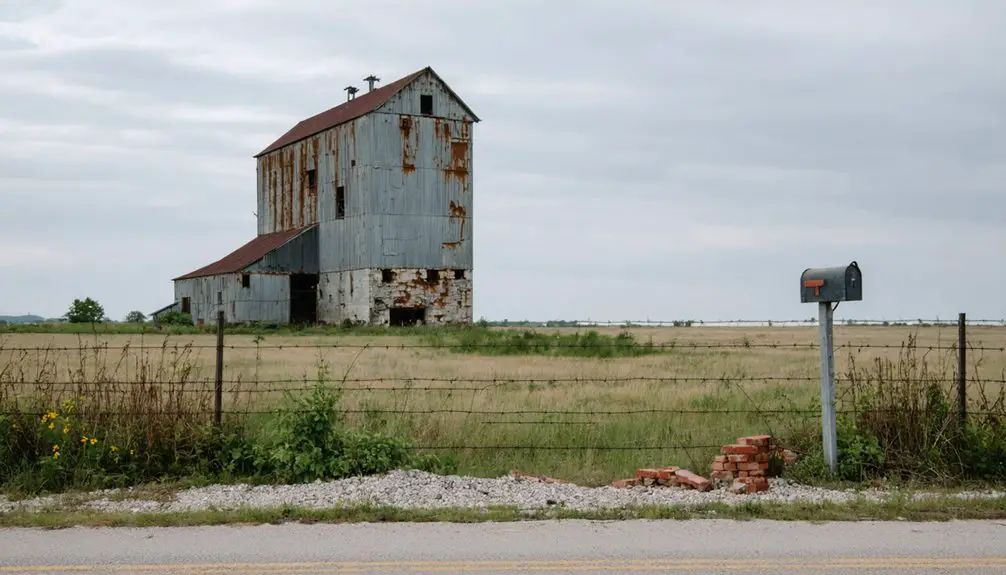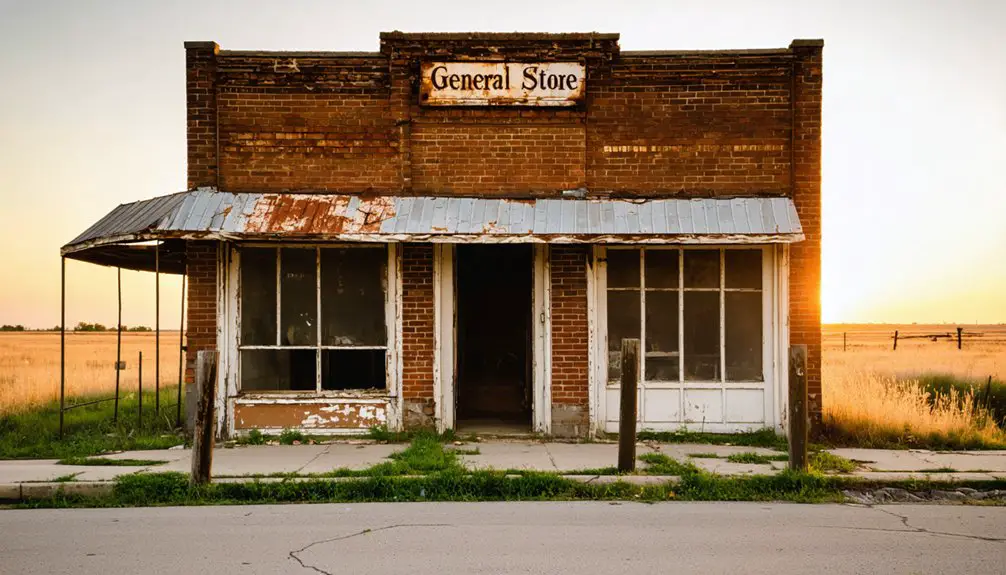Douglas City stands as one of Oklahoma’s historic all-Black settlements, founded in 1903 by Lemuel Jackson, James Roper, and John Grayson across 160 acres. You’ll find this former boomtown transformed from a thriving community of 200 residents to a present-day population of 50. While it’s weathered economic challenges, the town’s railroad heritage, mid-century structures, and cultural significance as a post-Reconstruction settlement hold countless stories of perseverance and community spirit.
Key Takeaways
- Douglas City was founded in 1903 as an all-Black town in Indian Territory, reaching a peak population of 200 residents.
- The town declined from 200 to 50 residents due to economic challenges, agricultural market fluctuations, and transportation difficulties.
- Historic structures include a 1957 high school building, railroad infrastructure, and remnants of commercial buildings from early 20th century.
- Despite ghost town status, Douglas City remains incorporated with approximately 50 residents maintaining basic infrastructure and municipal services.
- The community’s legacy contributes to academic studies of racial settlement patterns and regional heritage tourism in Oklahoma.
Origins of a Black Settlement
While many African Americans sought refuge in Oklahoma after the Civil War, Douglas City emerged as part of a larger movement that established over fifty all-Black towns in Indian Territory between 1865 and 1920.
Oklahoma’s Indian Territory became a sanctuary for Black communities, with over fifty towns established as safe havens after the Civil War.
You’ll find that the founding motivations stemmed from a desire for economic independence and protection, as African Americans viewed Oklahoma as their “promised land.”
In 1903, entrepreneurs Lemuel Jackson, James Roper, and John Grayson established Douglas City across 160 acres, facing the same settlement challenges that drove other Black communities to band together.
They’d overcome these obstacles by creating a self-sufficient town complete with a general store, cotton gin, gristmill, and church. Cotton production became the economic backbone of the community, as it did for many All-Black towns in Oklahoma.
The town’s strategic location between Arkansas and Oklahoma territories helped integrate new settlers and foster commerce.
Like many settlements established by newly emancipated freedmen, Douglas City represented an escape from the political and social oppression of the South.
Life During the Boom Years
If you’d visited Douglas during its peak years around 1940, you’d have found a bustling agricultural community of 140 residents centered around the Farmer’s Co-Op established in 1929.
The Denver, Enid and Gulf Railroad‘s arrival in 1902 transformed the town’s economic prospects by connecting local farmers to broader markets and stimulating commerce. Like many Oklahoma communities during the Great Depression, Douglas residents faced hardship until New Deal programs helped stabilize the local economy. Federal programs drove a shift away from farming, as agricultural employment dropped significantly from 70% to 37% by 1930.
The daily rhythm of community life revolved around farming activities, small businesses serving basic needs, and social gatherings at local churches and schools.
Daily Community Activities
During Douglas City’s boom years, the primarily black community of around 200 residents maintained a vibrant social fabric through daily activities centered on schools, churches, and local businesses.
You’d find neighbors frequenting the general store, children attending the local schoolhouse, and families gathering at church functions that anchored the town’s spiritual life.
Community gatherings and local celebrations brought everyone together regularly, featuring music, dancing, and storytelling that strengthened social bonds.
The arrival of the railroad in the mid-1890s brought new economic opportunities and social connections to the growing town.
You might’ve witnessed informal sports games, shared meals, or town meetings at the school building.
Daily work revolved around various trades, with residents supporting each other through agricultural activities, local commerce, and public services.
The town’s modest size meant you’d know virtually everyone, creating a tight-knit network of mutual support and shared experiences.
Like many of Oklahoma’s two thousand ghost towns, Douglas City would eventually succumb to the economic pressures and social changes that reshaped the region.
Railroad Economy Impact
As the Denver, Enid and Gulf Railroad established its presence in 1902, Douglas City transformed from an isolated settlement into a bustling economic hub. The railroad expansion brought unprecedented opportunities, connecting you to major markets and fostering rapid economic transformation throughout the region.
You’d have witnessed these dramatic changes through:
- Steam locomotives revolutionizing travel times, covering in one hour what used to take a full day by horse.
- Round-the-clock rail operations creating constant commercial activity.
- New job opportunities in construction, train operations, and support services.
- Development of essential infrastructure including warehouses and shipping facilities.
The Atchison, Topeka and Santa Fe Railway’s acquisition in 1907 further amplified Douglas City’s growth, establishing it as a key point in Oklahoma’s expanding transportation network. Similar to the MK&T Railway line that laid the first tracks in Indian Territory in 1870, this connection opened new possibilities for local businesses and resource development. The Post-Civil War Treaty of 1866 had paved the way for these vital railroad developments by first allowing railways into Indian Territory.
Economic Factors Behind the Decline
Though many ghost towns declined due to sudden resource depletion, Douglas City’s economic downfall stemmed from a complex web of interconnected factors. The town’s economic vulnerability originated from its heavy reliance on agriculture and small-scale ranching, leaving it exposed to market fluctuations and declining crop prices. Like red dirt roads in Fallis today, unpaved rural routes made transportation difficult and expensive.
Unlike nearby boomtowns that thrived on oil and mining, Douglas couldn’t diversify its economic base. The Great Depression dealt a particularly devastating blow to the already struggling community.
While surrounding towns found prosperity in diverse industries, Douglas City remained trapped in its singular economic focus.
You’ll find that labor migration played a significant role in the town’s decline. As younger workers sought opportunities in urban centers, the population plummeted from 200 to about 50.
This exodus created a devastating cycle: fewer workers meant reduced agricultural production, while a shrinking consumer base forced local businesses to close. Limited municipal revenues prevented infrastructure improvements, further accelerating the town’s isolation from regional commerce.
Notable Structures and Landmarks
While much of Douglas City has succumbed to time, several notable structures still mark its historical significance. The town’s historic architecture reflects its early 20th-century prominence, with remnants that tell the story of a once-thriving community.
- The 1957 high school building stands as one of the most prominent structures, showcasing mid-century design and community preservation efforts.
- Railroad infrastructure, including vintage signs and track segments, demonstrates Douglas’s essential transportation links.
- Religious landmarks and a cemetery serve as enduring cultural touchstones, marking generations of local history.
- Former commercial buildings’ foundations hint at the bustling main street that once served nearly 200 residents.
You’ll find these remaining landmarks often boarded up or fenced off, yet they’re significant pieces of Douglas’s architectural heritage, offering glimpses into Oklahoma’s territorial development.
Present-Day Community Status

Despite its ghost town designation, Douglas maintains its status as an incorporated Oklahoma town with approximately 50 residents today.
Though labeled a ghost town, Douglas defies typical abandonment by maintaining incorporation and a small but steady population.
You’ll find community resilience evident in the town’s ability to sustain basic infrastructure and municipal services, even as many similar ghost towns have completely disappeared.
The population dynamics tell an interesting story of decline and modest recovery. While the town’s numbers dropped from nearly 200 residents a century ago, recent years have shown a slight uptick in population.
Today’s residents likely commute for work or engage in agricultural activities, as the local economy remains limited.
Though public facilities like schools and post offices are no longer operational, the town’s incorporation status reflects an ongoing commitment to preserving its identity and administrative autonomy.
Historical Legacy and Cultural Impact
The historical significance of Douglas City extends far beyond its current population figures. As one of Oklahoma’s African American settlements during the post-Reconstruction era, this community exemplified cultural resilience in the face of segregation and social challenges.
You’ll find its impact preserved through various historical records that showcase the town’s unique community identity.
Key aspects of Douglas City’s legacy include:
- Peak population of 200 residents who maintained a self-sufficient black community
- Documentation in ghost town listings and photographic archives
- Contribution to academic studies of racial settlement patterns in Oklahoma
- Role in regional heritage tourism and historical research
Today, Douglas City’s story continues to inform discussions about minority settlements, migration patterns, and community formation during Oklahoma’s shift to statehood.
Frequently Asked Questions
What Was the Closest Major City to Douglas City During Its Peak?
Like a magnetic beacon drawing settlers westward, Enid was your closest city during Douglas City’s heyday, serving as the region’s bustling hub with significant population growth and essential railroad connections.
Were There Any Famous Residents or Visitors to Douglas City?
You won’t find any documented famous residents or notable visitors to this small community. Historical records don’t show any widely recognized personalities associated with the town during its inhabited years.
What Businesses or Industries Operated in Douglas City Besides Agriculture?
Through railways and freight, through trade and transport, you’d find commerce centered on the railroad station, a grocery store with post office, and likely services supporting railroad workers and travelers.
Did Douglas City Have Its Own Newspaper or Other Media Outlets?
You’ll find that *The Douglas News* served as the town’s primary newspaper from 1904 to 1906, representing a brief but significant period in local newspaper history and media influence.
What Natural Disasters or Significant Weather Events Affected Douglas City’s History?
You won’t find documented tornado impacts or major flood events affecting Douglas City’s history, despite its location near the Salt Fork Arkansas River and Oklahoma’s severe weather patterns.
References
- https://en.wikipedia.org/wiki/List_of_ghost_towns_in_Oklahoma
- https://www.youtube.com/watch?v=5NI-cU4nQ6w
- https://www.kgou.org/oklahoma-news/2018-10-01/how-curious-an-all-female-ghost-town
- https://www.youtube.com/watch?v=-jYN1_E2VV0
- https://kids.kiddle.co/List_of_ghost_towns_in_Oklahoma
- https://www.justiceforgreenwood.org/black-settlement-in-oklahoma/
- https://www.okhistory.org/publications/enc/entry?entry=AL009
- http://dcminnerblues.com/black-towns/
- https://www.soulofamerica.com/black-towns/oklahoma/
- https://plainshumanities.unl.edu/encyclopedia/doc/egp.afam.006.html



